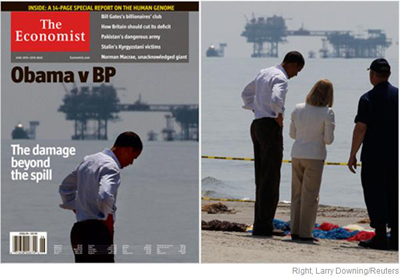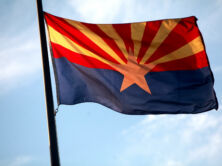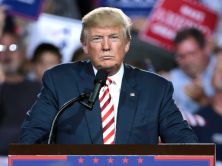
The Economist doctored the cover image on the left. See original Reuters photo on the right. (Credit: New York Times)
The New York Times’ media decoder called out The Economist July 5 for doctoring its June 19 cover image of President Barack Obama.
The cover photograph shows a lonely Obama on the beach looking down as if in deep thought. The headlines state: “Obama v BP” and “the damage beyond the spill.”
The Times wrote that the photo “was the ideal metaphor for a politically troubled president.” But alas, the photo was doctored.
As The New York Times reported, the original photo was taken May 28 by a Reuters photographer, Larry Downing. In reality, the Reuters photo shows Obama standing next to Lafourche parish president Charlotte Randolph and Coast Guard Adm. Thad W. Allen.
Blogger Kevin Drum’s July 5 analysis, published on the nonprofit news site Mother Jones, shows “the full transformation” from the original photo to the doctored cover. Turns out that Allen was cropped out, the image was darkened, and Randolph was digitally removed from the photo.
Thomson Reuters said that “Reuters has a strict policy against modifying, removing, adding to or altering any of its photographs without first obtaining the permission of Reuters and, where necessary, the third parties referred to,” The New York Times reported.
The Economist’s deputy editor, Emma Duncan, wrote in an e-mail to The New York Times that Randolph was edited out “not to make a political point, but because the presence of an unknown woman would have been puzzling to readers.”
“I asked for Ms. Randolph to be removed because I wanted readers to focus on Mr. Obama, not because I wanted to make him look isolated. That wasn’t the point of the story. ‘The damage beyond the spill’ referred to on the cover, and examined in the cover leader, was the damage not to Mr. Obama, but to business in America,” Duncan wrote.
But, Roy Greenslade of The Guardian doesn’t quite buy that. Greenslade wrote July 6 “Well, it’s an interesting explanation, and I respect Duncan’s integrity. But the main headline said ‘Obama v BP’, so am I alone in finding her answer just a little disingenuous?”
Duncan wrote that the magazine does edit photos for its cover, citing the image of Obama with a bandaid on his head, but noted the magazine doesn’t “edit photos in order to mislead”
Jed Lewison wrote July 5 on the Daily Kos that ” Digital image processing can be a great way to make a point, but it’s wrong to create a fake image and pass it off as real to an unsuspecting audience.”
Jonathan Turley blogged July 6 noting that by Photoshopping out the “much shorter Randolph” out of the photo, The Economist suggests Obama is leaning over “in deep contemplation,” when he’s really leaning over to listen to Randolph. He is, in other words, not isolated, but is doing his job in consultation with local officials.
Turley cited the National Press Photographers Association‘s code of ethics, which advises that “editing should maintain the integrity of the photographic images’ content and context. Do not manipulate images or add or alter sound in any way that can mislead viewers or misrepresent subjects.”
The Society of Professional Journalists’ code of ethics advises that journalists “make certain that headlines, news teases and promotional material, photos, video, audio, graphics, sound bites and quotations do not misrepresent. They should not oversimplify or highlight incidents out of context.” and “never distort the content of news photos or video. Image enhancement for technical clarity is always permissible. Label montages and photo illustrations.”






